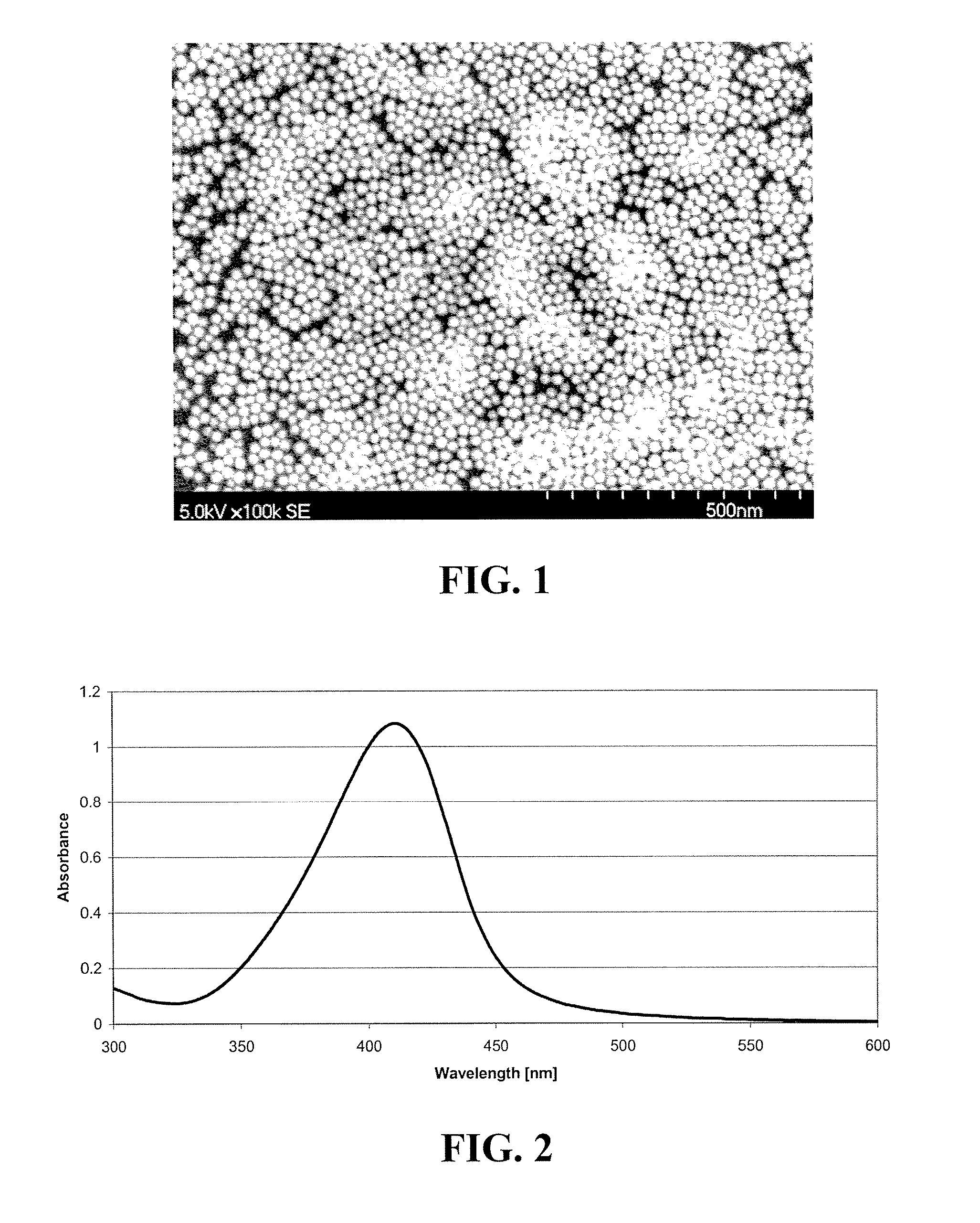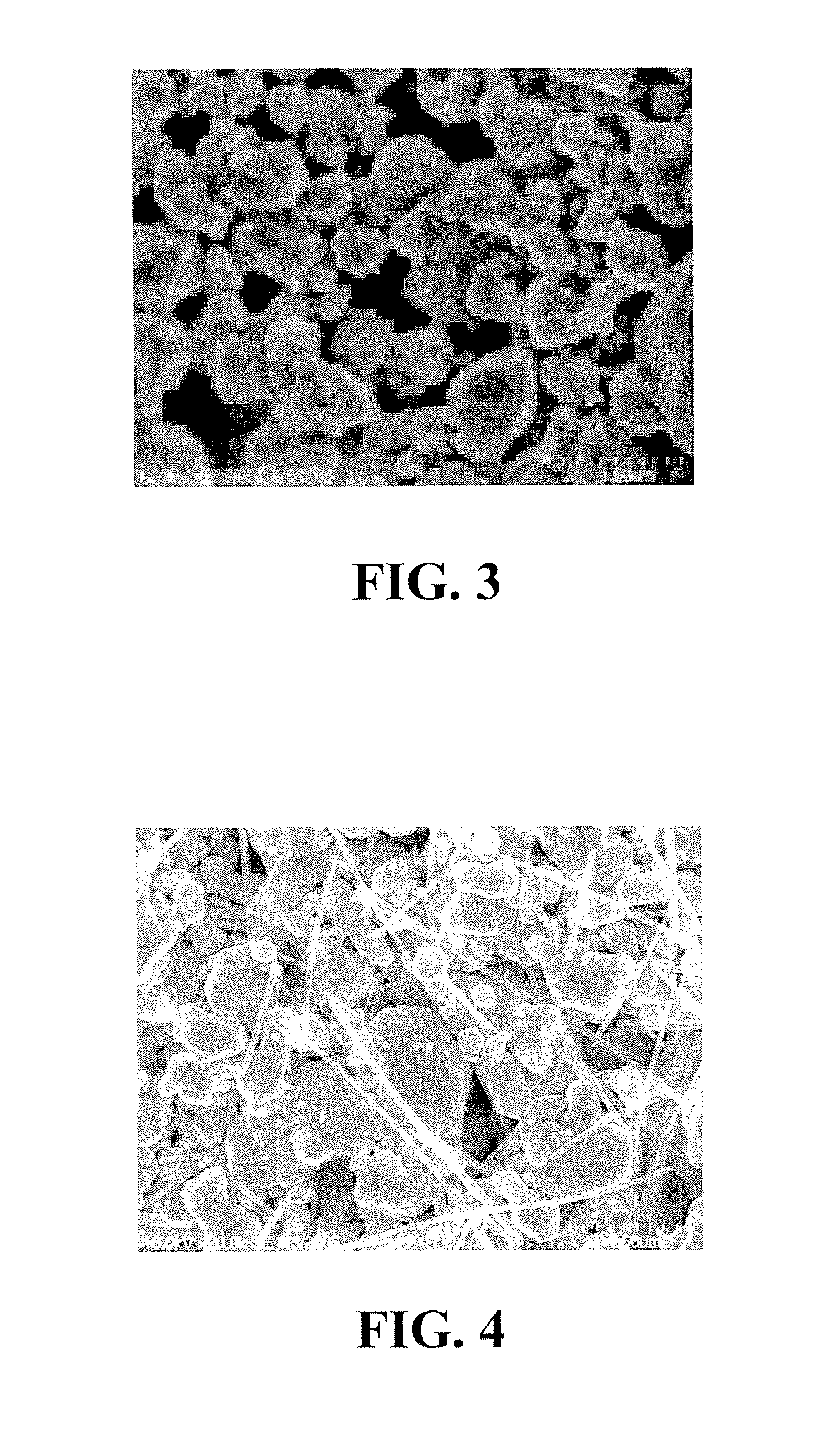Production of metal nanoparticles
a technology of metal nanoparticles and metal nanoparticles, which is applied in the direction of applications, inks, transportation and packaging, etc., can solve the problems of inability to produce large “chunks” and needle-like particles, process may yield metal nanoparticles with inconsistent properties, and the size and shape of particles formed in the modified polyol process are not uniform
- Summary
- Abstract
- Description
- Claims
- Application Information
AI Technical Summary
Benefits of technology
Problems solved by technology
Method used
Image
Examples
example 1
Comparative
[0103] PVP (1000 g, M.W. 10,000, ISP) was weighed into a tray. The PVP was, depending on the Sample, either heated at 70° C. for 15 hr, or not heated at all prior to mixing with ethylene glycol. After cooling (for heated runs) to room temperature, the PVP was transferred into a 4-L Erlenmeyer flask. Ethylene glycol (2.5 L) was added to the flask. The mixture was then shear mixed until completely dissolved at room temperature which gradually increased to 50-60° C. due to mechanical and shear friction energy transfer to the polymer and solvent.
[0104] In a separate beaker, silver nitrate (128 g) was weighed. Ethylene glycol (500 mL) was added to the beaker. The mixture was then rapidly stirred on a magnetic stirrer until complete dissolution of the silver nitrate.
[0105] The PVP solution was stirred using a mechanical, overhead mixer while heating to 120° C. The silver nitrate solution was then rapidly added to the PVP solution, at which point the temperature of the combin...
example 2
Effect of PVP heating
[0109] PVP containing between 0.1 and 1 wt. % formate (63 g, M.W. 10,000, ISP) was weighed into a 500 mL beaker. The PVP was then heated at 100° C. for 70-90 hr. After cooling to room temperature, ethylene glycol (157 g) was added to the beaker. The mixture was then shear mixed for 10-30 min. at room temperature.
[0110] In a separate beaker, silver nitrate (8 g) was weighed. Ethylene glycol (31 g) was added to the beaker. The mixture was then rapidly stirred on a magnetic stirrer until complete dissolution of the silver nitrate.
[0111] The PVP solution was stirred at 300 RPM using a mechanical, overhead mixer while heating to 120° C. The silver nitrate solution was then rapidly added to the PVP solution, at which point the temperature of the combined solutions dropped to between 108 and 114° C.
[0112] The temperature of the solution was allowed to return to 120° C. and stabilized at this temperature for about 60 to 100 minutes. The reaction mixture was allowed ...
example 3
Effect of PVP Heating and Employing a Non-Polyol Reducing Agent in the First Solution
[0113] PVP containing about 0.6 wt. % formate (63 g, M.W. 10,000, ISP) was weighed into a 500 mL beaker. The PVP was then heated at 100° C. for 70 hr. After cooling to room temperature the formate content was determined to be 0.04 wt. %. Ethylene glycol (157 g) was added to the beaker. The mixture was then shear mixed for 15 min. at room temperature.
[0114] In a separate beaker, silver nitrate (8 g) was weighed. Ethylene glycol (31 g) was added to the beaker. The mixture was then rapidly stirred on a magnetic stirrer until complete dissolution of the silver nitrate.
[0115] The PVP solution was stirred at 300 RPM using a mechanical, overhead mixer while heating to 120° C. 0.19 g (0.35 wt. % based on PVP) formic acid was added to the solution. After 3 minutes the silver nitrate solution was then rapidly added to the PVP solution, at which point the temperature of the combined solutions dropped to 111...
PUM
| Property | Measurement | Unit |
|---|---|---|
| Temperature | aaaaa | aaaaa |
| Temperature | aaaaa | aaaaa |
| Temperature | aaaaa | aaaaa |
Abstract
Description
Claims
Application Information
 Login to View More
Login to View More - R&D
- Intellectual Property
- Life Sciences
- Materials
- Tech Scout
- Unparalleled Data Quality
- Higher Quality Content
- 60% Fewer Hallucinations
Browse by: Latest US Patents, China's latest patents, Technical Efficacy Thesaurus, Application Domain, Technology Topic, Popular Technical Reports.
© 2025 PatSnap. All rights reserved.Legal|Privacy policy|Modern Slavery Act Transparency Statement|Sitemap|About US| Contact US: help@patsnap.com


